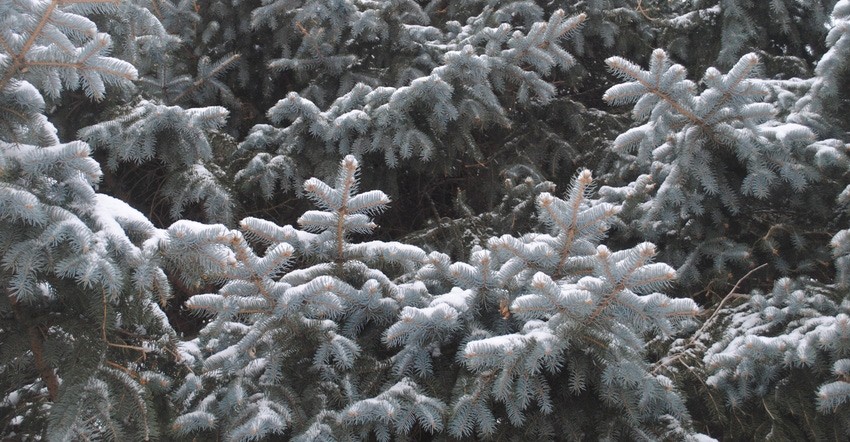December 17, 2020

Editor's note: In our new column, Farm and Garden, we ask the experts questions related to gardening, lawns, trees, and farmstead orchards and landscapes. Here are their answers.
Is it OK to apply livestock manure on your garden during the winter to boost fertility? Manure is a great soil amendment, providing both organic matter and nutrients to the soil. But when fresh or raw manure is used in the vegetable garden, food safety issues are a serious concern. Common human pathogens found in manure include bacteria (E. coli, salmonella, shigella), viruses (norovirus, hepatitis A) and parasites (cyclospora, cryptosporidium).
Curing or aging manure is not enough to make it safe. The Food Safety Modernization Act identifies two composting methods — aerated static composting and turned composting — to kill off pathogens. With aerated static composting, manure should reach a temperature of 131 degrees F for at least three days, followed by a curing stage at cooler temperatures.
With turned composting, manure should have a minimum of five turnings and reach a minimum of 131 degrees for 15 days, followed by a curing stage. Composted manure using these methods can be applied with a zero-day application interval.
If raw or uncomposted manure is used, fall applications are a good practice — incorporating the manure after garden harvest is completed and allowing the winter conditions to decrease pathogen load. In this instance, National Organic Standard guidelines for use of raw or untreated manure by growers is as follows:
Apply manure at least 90 days before harvest if the vegetable’s edible portion does not contact the soil.
Apply manure at least 120 days before harvest if the vegetable’s edible portion does contact the soil.
It’s also important to be cautious with compost created using plant waste, such as grass clippings, leaves or kitchen waste. Although the materials do not originate from animal manure, the potential for dog, cat or wildlife feces to be in the mix is a real danger.
Do I need to be concerned about my flower beds, trees and shrubs around sidewalks or driveways where I use de-icers in the winter? Deicing agents often are needed in winter for safety, but they can be harmful to plants. Splashing of salty water from driveways or roads can cause burning of plant foliage, particularly evergreens such as arborvitae, spruce or pine.
High soil salt levels after winter applications changes the soil structure long term. Soil becomes more compacted, restricting the availability of nutrients, water and oxygen to plants.
In summer, high soil salt levels decrease a plant’s ability to absorb sufficient water — even when water is available — in a condition called chemical drought. Symptoms of salt damage include stunting, leaf burn, root damage and plant death.
To help limit issues, use a deicing product with the lowest damage potential and the smallest amount of product needed. Avoid piling snow containing salt on turfgrass. Keep products on hand that improve your footing on slick surfaces — such as sand, sawdust or cat litter — to be used instead of traditional deicing products or blended with them.
Common deicing compounds are listed here in order of potential plant damage, with the most damaging first. These may be used alone or blended together to improve performance or reduce damage to concrete or landscapes:
Sodium chloride. This is the least expensive product and is commonly used on roads. It has a high burn potential for landscape plants.
Urea. It can harm landscape plants and cause runoff pollution in ponds and waterways.
Potassium chloride. Known as muriate of potash, potassium chloride is less damaging than sodium chloride.
Calcium chloride. The most effective deicing product at low temperatures, calcium chloride works down to minus 25 degrees F. It will not damage vegetation if used as directed.
Magnesium chloride. This is sprayed on roads before a snowstorm to prevent ice bonds from forming, making ice and snow removal easier. It causes very little damage to concrete or metal. It's also gentle on landscape plants, and it is pet safe if used as directed.
Acetates. These can be found in three forms — calcium magnesium acetate, sodium acetate and potassium acetate. CMA is a salt-free product and is the safest product for use around pets and landscape plants. CMA is made from dolomitic limestone and acetic acid (the principal component of vinegar). Studies have shown the material has little effect on plants. It also has a very low level of damage to concrete or metal.
Beet juice de-icers. These are a newer organic option derived from beet juice. They contain only 12% sodium chloride, much less than traditional sodium chloride. Beet juice products are fully biodegradable. However, some research has shown potential problems with aquatic insects. So, it should not be applied where melt runoff will move to aquatic areas. It is available to homeowners as Green Gobbler Pet Safe Ice Melt, Snow Joe Beet It Snow & Ice Melter, Organic Melt Premium Granular Ice Melter and others.
Browning is a Nebraska Extension educator in Lancaster County. Contact her at [email protected].
You May Also Like




